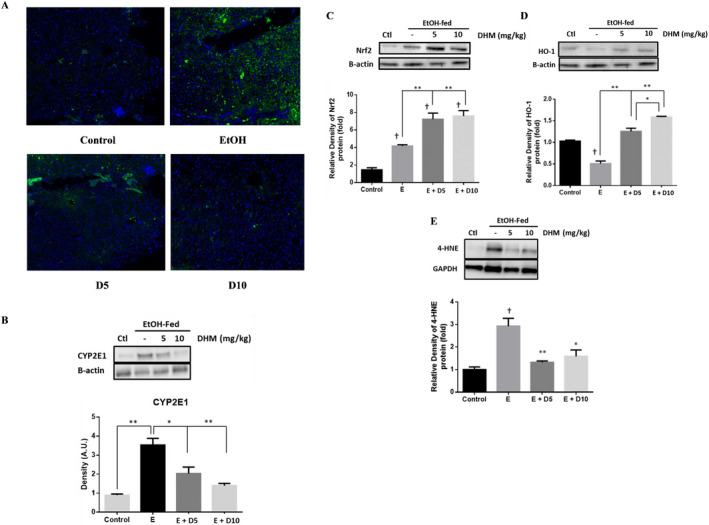Fig. 6.

DHM reduces hepatic CYP2E1 expression and increases the hepatic expression of Nrf2 and HO‐1 antioxidant pathways. (A) Immunohistochemistry results of CYP2E1 in livers suggest that DHM inhibited the expression of CYP2E1 in ethanol (EtOH)‐fed mice relative to EtOH only (green = CYP2E1, blue = nuclei; n = 6/group). (B) Representative Western blot illustrating that DHM significantly reduces the hepatic expression of CYP2E1 relative to untreated EtOH‐fed mice (n = 3/group; *p < 0.05 5 mg/kg DHM and **p < 0.01 10 mg/kg DHM). (C) EtOH‐fed mice showed a significant increase in Nrf2 relative to water controls (n = 3/group; *p < 0.05). DHM (5 and 10 mg/kg) significantly increased the expression of Nrf2 in EtOH‐fed mice livers relative to EtOH controls (n = 3/group; **p < 0.01). (D) EtOH‐fed mice displayed a significant reduction in HO‐1 protein expression relative to water controls (n = 3/group; **p < 0.01). 5 and 10 mg/kg DHM significantly increased the expression of HO‐1 protein expression relative to EtOH only (n = 3/group; **p < 0.01; significant difference between 5 and 10 mg/kg DHM, *p < 0.05). (E) EtOH‐fed mice showed a significant increase in the hepatic expression of 4‐HNE in comparison with water‐fed controls (n = 3/group; †p < 0.05). DHM (5 and 10 mg/kg) significantly reduced the expression of 4‐HNE in the liver (n = 3/group; **p < 0.01 and *p < 0.05, respectively). Bar graphs were generated by quantifying blots from 3 independent experiments using ImageJ and normalized against intensity of the untreated lane. Data represented as mean ± SEM. *p < 0.05 and **p < 0.01 compared with corresponding EtOH controls; †, p < 0.05 versus water‐fed control. n = 3/group.
